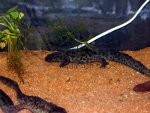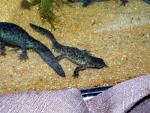Pleurodeles waltl - Proper Care & Pictures
Quick links - Answers
Brief Description
Aqua-fish.net is devoted to fish keeping, however many aquarists keep other pets too; Thus the below-shown article is one of the articles that are devoted to exotic pets. If you keep these creatures, you're welcome to share your experiences at the bottom of this page!
Introduction
Pleurodeles waltl is a member of the newt family, it is more commonly known as the Ribbed newt, Iberian ribbed newt or even the Spanish ribbed newt. The common names are derived from two things, its natural locality which is the Iberian peninsula where it is commonly found to the south of this land mass but it is also found in Morocco. The second reason for its common name is due to a specialised defence mechanism that this newt has evolved over the generations to prevent predation. Along its flanks there are tubercles which allow the ribs to protrude when the newt feels threaten, this is in turn makes it awkward for any predator to devour the newt as well as the sharp edges on the ribs inflicting potential damage to anything willing to tackle this creature.
The ribbed newt is one of the larger specimens that belong to this family, in the wild mature specimens can reach up to 12 inches (30.48 cm) in length, like most live stock, if they are kept in an aquarium they tend to level out at a slightly smaller size.
They have also adapted to hiding away, their head shape has become flattened and their eye line is high on the head with the eyes aimed slightly upwards giving them a good scope of vision while hiding away.
The body shape of this newt is plumper and the tail length should match the total body length, if shorter this could be due to part of the tail being accidentally removed.
Specimens can vary in their body colouration from a dark grey to a lighter grey but all specimens will be covered in brownish blotches, these are more apparent on the belly are which is a lighter off white colour. Their skin has a rough texture that is irregular providing them with a tough exterior to cope with their demands in their natural habitat.
As we all know newts are amphibians but the ribbed newt seems to prefer to spend most of its time in the water only occasionally emerging out onto dry land, this can be a problem in their local waterways as they do need to keep moist and periods of drought are common but they can survive in small pools of water and if these dry out they will simply protect themselves from the glaring sun by hiding under rocks or other cover until the pools fill with rainfall again.
In recent years wild specimens are on the decrease due to land drainage and colonisation of the water ways by foreign invasive species to such an extent that it is close to being added to the endangered species list.
Housing your Ribbed newt
Salamanders and newts are excellent escape artists they can squeeze through the smallest of gaps but unfortunately if this situation occurs it usually results in their premature death. Always bear this in mind when selecting a tank set up for your newt, make sure that a tight fitting lid is used to prevent any escapees.
These newts do not have a lot of special requirements but they do have a few that must be covered to keep the newt successfully and give it a full lifespan. The substrate used in the tank can be gravel but make sure that the grain size is not too small, they do have a habit of swallowing gravel with their food if this is the case. They will need an area of dry land even though the ribbed newt spends most of its life in the water. For the natural look you can build a beach area from a pile of rocks or nowadays there are artificial floating décor available that also serve the same purpose. The water level should not be too high, above 6 inches (15.24 cm) of water is fine but do not go any higher than 8 - 9 inches (~ 20 - 23 cm) maximum.
Temperature wise, they prefer a tank temperature just above 20°C (approx. 72-74°F), higher temperatures can affect the newts health. If you live in mid climates then there should be no need to add an heater to the tank, this may not be the case during the winter months so through this part of the year, monitor the temperature with a reliable thermometer and add a small heater if required.
To filter the water I find it best to use an internal filter laid on its side due to the low water level, these can easily be disguised by using décor but cover the intake over with sponge incase the newts trap any of their limbs.
Water changes can be performed at a rate of 10% weekly to keep the quality high, the added benefit of using a tight fitting lid is that it will also keep the atmosphere above the water line humid, this is ideal for the newts.
Lighting is not critical, it is more for the keeper as the newts are quite happy to kept in natural daylight all of the time. If you are using lighting then it is best to use fluorescent tubes as these produce little heat and only use the lights for a few hours each day to mimic daylight and night-time hours.
Feeding your Ribbed newt
In the wild the newts diet consists of insects, crustaceans and small worms, in the tank you have the chance to offer them a wide range of foods either commercial or not so you can give them a varied diet to keep them healthy. Feeding the same food with every meal cam bring on the onset of boredom with the food and can mean that the newt will start to refuse meals every now and again, offering different foods will prevent this and keep them interested. The list of foods in this section are only recommendations, some specimens may prefer some of the foods more than others, each specimen is different but if they don’t like a type of food when you first offer it, persevere and they may learn to like the choice that you are offering them. They do need meaty foods such as chopped earthworms, chopped prawns,commercial turtle pellets, commercial newt food or even small insects that you capture purposely for the meals.
The food can be offered by using tweezers or your fingers, they may be wary of you initially but in time they will learn to trust you and eat from your fingers. If feeding dead insects and the chopped meaty foods it may pay off to dangle the food near the ribbed newt or slightly above its head to create interest, fooling the newt into thinking that they have a live meal, at one time feeder fish were offered but this practice can bring disease into the tank and should be avoided.
Only offer enough food that can be consumed in a five minute period, allow the newt a little time to smell the food, this is an important part of their senses. Any uneaten food should be removed immediately before it gets the chance to decay in the tank.
Feeding every other day gives the newts the chance to digest their food properly and also creates a regime that the newts adapt to preventing any digestive problems or blockages.
Breeding in the aquarium
Sexing the ribbed newt is quite an easy affair as long as you have males and females to compare against each other. They also breed quite easily in the tank so make a good project for potential keepers who are interested in the breeding side of caring for these creatures. Males will develop slightly longer tails than the females and just prior to their breeding seasons will develop pads on his arms, these are known as “nuptial pads” and aid the male to grasp the female.
In the wild the ribbed newt tends to have two main breeding periods, in the spring and during the later summer months. To encourage breeding it is wise to leave off the lighting for a few weeks to imitate the dark winter months so that when the lighting returns it fools the newts into thinking that it is springtime. The water level should also be raised by a couple of inches and raising the water temperature slightly, all of these actions will induce spawning.
The mating process begins with the male grasping onto the female by grabbing her arms from underneath, after a few hours the male will release one arm and swing in front of the female. He will then make a succession of turns whilst depositing a sperm sac, this is known as a “spermatophore”. He will then turn the female over the sperm sac and she will pick this up and her eggs will be fertilised.
The batch size for the eggs can be anything from 100 right up to 1000 and these are scattered around the vegetation. The eggs are always safe with the parents but once they hatch they are seen as food so if you wish to raise as many young as you can, remove the eggs before they hatch.
Keep the temperature at a constant 20°C (72°F), any higher and the larva will all develop as males, any lower and the larva will become stressed. They can be fed on newly hatched brine shrimp or rotifers until they morph into juveniles who can accept the same diet as the parents but chopped smaller to suit the smaller mouths and stomachs.
Footnote:-
All amphibians can produce toxins from pores in their skins, if you wish to handle them always wash your hands thoroughly to prevent any risk of diseases or infections being passed to yourself!


